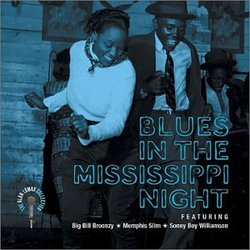| All Artists: Alan Lomax Title: Blues in the Mississippi Night Members Wishing: 5 Total Copies: 0 Label: Rounder Select Original Release Date: 1/1/1947 Re-Release Date: 7/22/2003 Album Type: Original recording remastered Genres: Blues, Pop Styles: Chicago Blues, Delta Blues, Piano Blues Number of Discs: 1 SwapaCD Credits: 1 UPC: 682161186023 |
Search - Alan Lomax :: Blues in the Mississippi Night
 | Alan Lomax Blues in the Mississippi Night Genres: Blues, Pop
|
Larger Image |
CD Details |
CD ReviewsPriceless Steve Hinrichsen | CA, USA | 10/19/2003 (5 out of 5 stars) "Not long ago a couple of fellow blues cronies of mine and I were having a couple of cold ones and discussing the music that we love so much, when I posed the question: "If you could go back in time and be anyone in blues history, who would you choose to be?" The usual array of legends were the answers I received along with a couple of odd looks along with "Who is he?" when I said I would choose Alan Lomax. For those of you who don't know, Alan Lomax was the fellow who recorded scads of blues, folk and bluegrass artists for the Library Of Congress and was responsible for the first ever recordings of the immortal Woody Guthrie and Muddy Waters. The men and women he met, and at times lived with, along with the music he was witness to and recorded are the stuff dreams are made of. This particular recording, Blues In The Mississippi Night (Rounder) is a very informal look at three Mississippi Delta legends in their own time, Big Bill Broonzy, Memphis Slim and the original Sonny Boy Williamson. Lomax brought the three to New York City as part of the Midnight Special series of concerts he was producing at Town Hall in 1947 and got them into Decca's recording studio. What you will find contained within is not just some great unrehearsed music but a fascinating, candid insight through the dialogue amongst them, into what inspired the blues and what it was like to live the life of not only a bluesman but as a person of color in the deep south and the hardships that came along with the territory. Lomax asked "Tell me what the blues is all about," as these three gentlemen had lived the blues all their lives. It was the last time he opened his mouth for the next two hours as his question was answered with song and conversation. Memphis Slim's crying rendition of "Life Is Like That," starts things off with his smooth piano amd Williamson adding some silky fills on harp. The three then begin discussing the origins and roots of the blues with the conversation segueing into a spiritual entitled "Long Meter Hymn," which is performed by an unknown congregation. This was added by Lomax along with other traditional african american folks songs at a later date for illustrative purposes. "I Could Hear My Name Ringin" is next with Williamson showing why he was the priemier harmonicist of his time accompanied only by Slim on piano for a tale of deceitful love. The trials and tribulations of the work/rock/levee/ prison camps are discussed next with Slim and Broonzy each singing bits and pieces of some of the tunes that pervaded such places. A stirring version of "Stackalee," have all three joining together for the best track on the album. "O'Berta" is another of Lomax's field recordings done on Parchman Farm in Mississippi performed by Bull and Group on vocal and hoes as is "Murderers Home," and "Don't You Hear Po Mother Callin." Memphis Slim pulls some amazing but all too short piano riffs out of his pocket on "Slow Blues," and then kicks things up a few hundred notches for "Fast Boogie," a blazing workout that will make you sweat just from listening. A previously unreleased number from Bill Broonzy, "Black,Brown And White Blues," pretty much sums up what the blues are really all about with it's poignant lyrics that explore the color boundries that once existed and still do in a few dark places in the world. When Slim,Broonzy and Williamson heard these recordings played back they begged Lomax to never tell anyone they made them because "You don't understand Alan. If these records came out on us, `they'd' take it out on our folks down home- burn them out and lord knows what else." They all insisted that their identities be kept secret. Lomax agreed and used the recordings for broadcast on the BBC Network and issued these recording on United Artists records in 1959. But he never revealed the identities of the artists and disguised the location they were made at until a 1990 reissue on Rykodisc. Blues In the Mississippi Night is not jam packed with music. On the contrary, the music serves as a backdrop for a history of the blues told by three men who actually lived it. Included are the original liner notes by Alan Lomax along with the transcribed conversations that took place as well as brief biographies of the three participants. With congress declaring 2003 as the Year Of The Blues it was only fitting that this historic recording was once again reissued. Anyone who hears this insightful record and is a fan of recordings from the blues' golden age of the 20's &30's will never hear them quite the same way again after hearing this."
|

 Track Listings (19) - Disc #1
Track Listings (19) - Disc #1